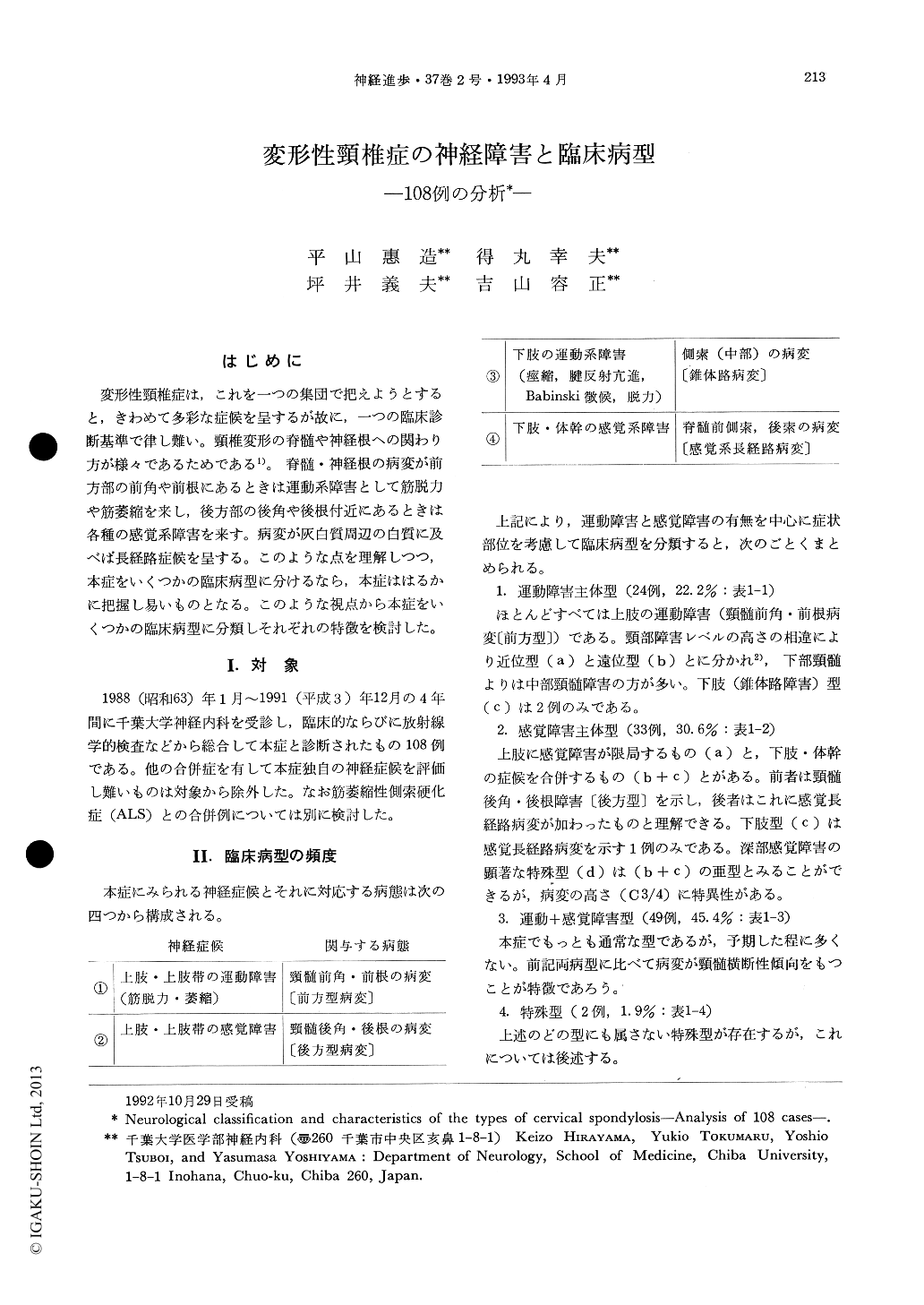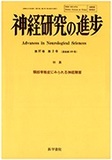Japanese
English
- 有料閲覧
- Abstract 文献概要
- 1ページ目 Look Inside
はじめに
変形性頸椎症は,これを一つの集団で把えようとすると,きわめて多彩な症候を呈するが故に,一つの臨床診断基準で律し難い。頸椎変形の脊髄や神経根への関わり方が様々であるためである1)。脊髄・神経根の病変が前方部の前角や前根にあるときは運動系障害として筋脱力や筋萎縮を来し,後方部の後角や後根付近にあるときは各種の感覚系障害を来す。病変が灰白質周辺の白質に及べば長経路症候を呈する。このような点を理解しつつ,本症をいくつかの臨床病型に分けるなら,本症ははるかに把握し易いものとなる。このような視点から本症をいくつかの臨床病型に分類しそれぞれの特徴を検討した。
108 cases of cervical spondylosis which were collected from case records of our clinic from January 1988 to December 1991 were classified into four categories according to the quality (muscular weakness and wasting or sensory disturbances) and distribution (in the upper limbs, lower limbs, or trunk) of signs and symptoms. Clinical characteristics of cervical spondylosis based on the classification were as follows.
(1) The total cases consisted of one fifth (24 cases, 22.2%) with a type of dominant motor in-volvement (weakness and/or atrophy), one third (33 cases, 30.6%) with a type of dominant sensory involvement, and less than a half (49 cases, 45.4%) with a type of motor and sensory involvement. (2) A type of proximal muscular atrophy of the upper limb(s) in which the mid-cervical cord was mostly involved (15 cases) had a rather acute onset and a tendency to arrest within one to three years, except for two cases in which muscular atrophy extended to the distal end(s). Triangular shape atro-phy of the cervical cord was present. (3) A type of distal muscular atrophy of the upper limb(s) with a low cervical cord lesion (7 cases) had restricted distal atrophy during a long period. Triangular shape atrophy of the cord was also present. (4) A type of sensory involvement of the upper limb(s) with a mid-to-low cervical cord lesion (18 cases) was divided into a half with unilateral and a half with bilateral involvement. Both halves often showed boomerang shape deformity of the cord. (5) Types of sensory involvement of the upper and lower limbs (6 cases) and of the limbs and the trunk (5 cases), both with a mid-to-low cervical cord lesion, often had also the boomerang shape deformity. The quality of sensory disturbances was sometimes different between the upper and the lower limbs. (6) A peculiar form characterized by deep sensory disturbances with an upper cervical cord lesion was present. (7) A type of motor and sensory involvement in which the mid-to-low cervical cord was mostly affected (49 cases), in comparing to the former types, tended to have a transverse lesion of the cord, and to have congenital canal stenosis (13 cases, 26.5%) as well as disc herniation (24 cases, 49.0%). (8) A pseudopolyneuropathy type which had distally-dominant sensory and/or motor symptoms in the four limbs was present (11 cases : 10.2% of the total cases). This type was observed in a type of motor and sensory involvement in which 6 cases were a type of the upper and lower limbs involvement, and 5 cases were a type of the limbs and trunk involvement. (9) A few patients (3.7% of the total) showed motor (2 cases), sensory (1 case), or both (1 case) involvement restricted to the lower limb(s). This type was considered a subtype of to pseudopolyneuropathy type.

Copyright © 1993, Igaku-Shoin Ltd. All rights reserved.


